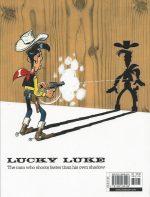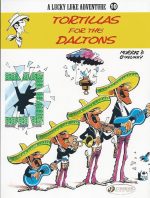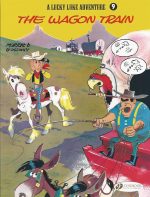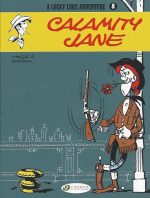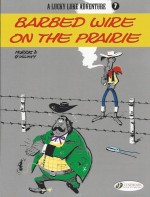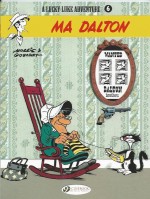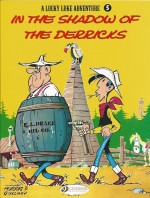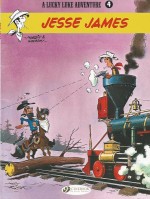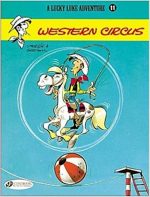
By Morris & Goscinny, translated by Frederick W Nolan (Cinebook)
ISBN: 978-1-905460-55-7
Lucky Luke is a rangy, good-natured, lightning-fast cowboy who roams the fabulously mythic Old West, having light-hearted adventures with his sarcastic horse Jolly Jumper whilst interacting with a host of historical and legendary figures.
His continuing exploits over seventy years have made him one of the best-selling comic characters in Europe (68 individual adventures totalling more than 300 million albums in 30 languages thus far), with the usual spin-off toys, computer games, animated cartoons and a plethora of TV shows and live-action movies.
Lucky was created in 1946 by Belgian animator, illustrator and cartoonist Maurice de Bévère (“Morrisâ€) and first seen in the 1947 Annual (L’Almanach Spirou 1947) of Le Journal de Spirou, before launching into his first weekly adventure ‘Arizona 1880’ on December 7th 1946.
Working solo until 1955, Morris produced nine albums of affectionate sagebrush spoofery before teaming with old pal and fellow trans-American tourist Rene Goscinny, who became the regular wordsmith as Luke attained the dizzying heights of legend, commencing with ‘Des rails sur la Prairie’ (Rails on the Prairie), which began serialisation in Spirou on August 25th 1955.
In 1967, the six-gun straight-shooter switched sides, transferring to Goscinny’s own magazine Pilote with ‘La Diligence’ (The Stagecoach). Goscinny created 45 albums with Morris before his untimely death, from whence Morris soldiered on both singly and with fresh collaborators.
Morris died in 2001 having drawn fully 70 adventures, plus some spin-off sagas crafted with Achdé, Laurent Gerra, Benacquista & Pennac, Xavier Fauche, Jean Léturgie, Jacques Pessis and others, all taking their own shot at the venerable vigilante…
Lucky Luke first amused British readers during the late 1950s, syndicated to weekly anthology Film Fun and again in 1967 in Giggle, where he used the nom de plume Buck Bingo.
In all these venues – as well as the numerous attempts to follow the English-language successes of Tintin and Asterix albums – Luke sported a trademark cigarette hanging insouciantly from his lip. However, in 1983 Morris – no doubt amidst both pained howls and muted mutterings of “political correctness gone mad†– deftly substituted a piece of straw for the much-travelled dog-end, which garnered him an official tip of the hat from the World Health Organization.
The most recent and successful attempt to bring Lucky Luke to our shores and shelves comes from Cinebook (who have rightly restored the foul weed to his lips on the interior pages, if not the covers…), and it’s clearly no big deal for today’s readership as we’re well past sixty translated books and still going strong.
Lucky Luke – Western Circus was the 25th collaboration – and now available both in English on paper and as an e-book – first published in Europe in 1970. The story is a classic range rider spoof of B-Movie westerns, with the laconic wanderer in fine form as he helps the (outlandishly) needy and deals with an iconic baddie in a most unique manner…
It all begins as our hero flees an Indian war party until saved by a most unlikely benefactor: soused circus impresario Captain Erasmus Mulligan (a deft tribute to the legendary W.C. Fields) and his pal Andy – a rather threadbare and motheaten Indian Elephant…
Soon Luke is helping fix a broken wagon and enjoying a free show courtesy of the far-travelled Western Circus; a talented band a bit past their best, who all came west to avoid clashing with insufferable showman P.T. Barnum…
The genial gunman’s private viewing is suddenly interrupted by an attack from the still-incensed braves of Chief Lame Bull, but Luke – and Andy – soon convince the raging warriors to watch the performance instead. Further violence is then forestalled by the arrival of a cavalry troop who escort the entertainers to Fort Coyote, a thriving township controlled by skeevy entrepreneur Corduroy “Diamond Tooth†Zilch.
The circus hits town just as the ambitious Zilch is promoting his annual Grand Rodeo, and when the populace seem more enthralled by even these tatty newcomers rather than Zilch’s old familiar festival, the big man decides The Show must not go on…
Before long his increasingly insidious antics devolve into utter farce and even a small-scale Indian war, and Luke and Jolly are compelled to slap on the greasepaint and join in with motley…
A deliriously rambunctious romp, Western Circus offers fast-paced, seductive slapstick and dry wit in copious amounts for another merry caper in the tradition of Destry Rides Again and Blazing Saddles. Superbly crafted by comics masters, it provides a wonderful introduction to a unique genre for today’s readers who might well have missed the romantic allure of an all-pervasive Wild West that never was…
© Dargaud Editeur Paris 1970 by Goscinny & Morris. © Lucky Comics.

